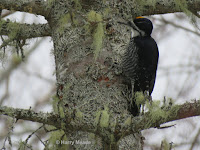BLACK-BACKED WOODPECKER
BLACK-BACKED WOODPECKER – (Picoides arcticus) – (See images below)
DESCRIPTION:The Black-backed Woodpecker has a black back (as its name implies), a black head (with a yellow patch for the male). The wings and upper tail are black. The under parts are white with black streaks on the sides. Sexes are similar. This woodpecker measures around 20 cm (8 inches) long.
VOICE: https://www.xeno-canto.org/species/Picoides-arcticus
NAME: The black-backed woodpecker is also known as the ‘Arctic’ three-toed woodpecker, and this is reflected in its Latin species name, even if it doesn’t breed in the Arctic. The Latin genus name ‘Picoides’ means ‘woodpecker’.
HABITAT: Preference for recently burnt forests.
DIET: Wood-boring beetles.
NESTING: Nests are a tree cavity. Between two and five white eggs are laid, incubated by both parents. Chicks are fed by both parents.
DISTRIBUTION: The breeding range encompasses much of the Canadian and upper USA forest, including Alaska. It is mainly a year-round resident on its territory, with only partial migration to the south in the mid-part of USA.
DISTRIBUTION MAP: https://en.wikipedia.org/wiki/Black-backed_woodpecker#/media/File:Picoides_arcticus_distr.png
ON PEI: Although a year-round resident and breeding on Prince Edward Island, the black-backed woodpecker is a rare occurrence for all seasons.
CONSERVATION: Black-backed woodpecker populations are difficult to estimate due to the temporary nature of their habitats (burnt forests). Globally they are not currently considered at risk.
NOTES: As for many other woodpeckers, the black-backed woodpecker has two forward and two backward toes, which allows better grip when climbing vertically on tree trunks. In addition, their tail feathers have stiff ends to provide more support.
Drumming: How can a woodpecker drum repeatedly on hard surfaces without sustaining brain damage? There is a study trying to answer that question. Researchers found that woodpeckers can peck millions of times in their lifetime without any apparent brain damage. Yet, the acceleration force (Gs) of their pecking is in the 1,300 range. Compare this with a force of only 80 Gs sustained by a human, which will result in a brain concussion
SIMILAR SPECIES: American Three-toed Woodpecker, Hairy Woodpecker
REFERENCES: https://www.borealbirds.org/bird/black-backed-woodpecker
https://www.mba-aom.ca/jsp/toc.jsp (Maritimes Breeding Bird Atlas)
https://www.audubon.org/field-guide/bird/black-backed-woodpecker
https://www.biologicaldiversity.org/species/birds/black-backed_woodpecker/index.html
https://www.allaboutbirds.org/guide/Black-backed_Woodpecker/id
DESCRIPTION:The Black-backed Woodpecker has a black back (as its name implies), a black head (with a yellow patch for the male). The wings and upper tail are black. The under parts are white with black streaks on the sides. Sexes are similar. This woodpecker measures around 20 cm (8 inches) long.
VOICE: https://www.xeno-canto.org/species/Picoides-arcticus
NAME: The black-backed woodpecker is also known as the ‘Arctic’ three-toed woodpecker, and this is reflected in its Latin species name, even if it doesn’t breed in the Arctic. The Latin genus name ‘Picoides’ means ‘woodpecker’.
HABITAT: Preference for recently burnt forests.
DIET: Wood-boring beetles.
NESTING: Nests are a tree cavity. Between two and five white eggs are laid, incubated by both parents. Chicks are fed by both parents.
DISTRIBUTION: The breeding range encompasses much of the Canadian and upper USA forest, including Alaska. It is mainly a year-round resident on its territory, with only partial migration to the south in the mid-part of USA.
DISTRIBUTION MAP: https://en.wikipedia.org/wiki/Black-backed_woodpecker#/media/File:Picoides_arcticus_distr.png
ON PEI: Although a year-round resident and breeding on Prince Edward Island, the black-backed woodpecker is a rare occurrence for all seasons.
CONSERVATION: Black-backed woodpecker populations are difficult to estimate due to the temporary nature of their habitats (burnt forests). Globally they are not currently considered at risk.
NOTES: As for many other woodpeckers, the black-backed woodpecker has two forward and two backward toes, which allows better grip when climbing vertically on tree trunks. In addition, their tail feathers have stiff ends to provide more support.
Drumming: How can a woodpecker drum repeatedly on hard surfaces without sustaining brain damage? There is a study trying to answer that question. Researchers found that woodpeckers can peck millions of times in their lifetime without any apparent brain damage. Yet, the acceleration force (Gs) of their pecking is in the 1,300 range. Compare this with a force of only 80 Gs sustained by a human, which will result in a brain concussion
SIMILAR SPECIES: American Three-toed Woodpecker, Hairy Woodpecker
REFERENCES: https://www.borealbirds.org/bird/black-backed-woodpecker
https://www.mba-aom.ca/jsp/toc.jsp (Maritimes Breeding Bird Atlas)
https://www.audubon.org/field-guide/bird/black-backed-woodpecker
https://www.biologicaldiversity.org/species/birds/black-backed_woodpecker/index.html
https://www.allaboutbirds.org/guide/Black-backed_Woodpecker/id
 |
| Black-backed woodpecker, Harry Meade |
 |
| Black-backed woodpecker, Harry Meade |
 |
| Black-backed woodpecker female - QC, by Cephas |
 |
| Black-backed woodpecker male, by USFWS |